Microeconomic Principles Assignment 2022
VerifiedAdded on 2022/10/19
|12
|2682
|10
Assignment
AI Summary
Contribute Materials
Your contribution can guide someone’s learning journey. Share your
documents today.
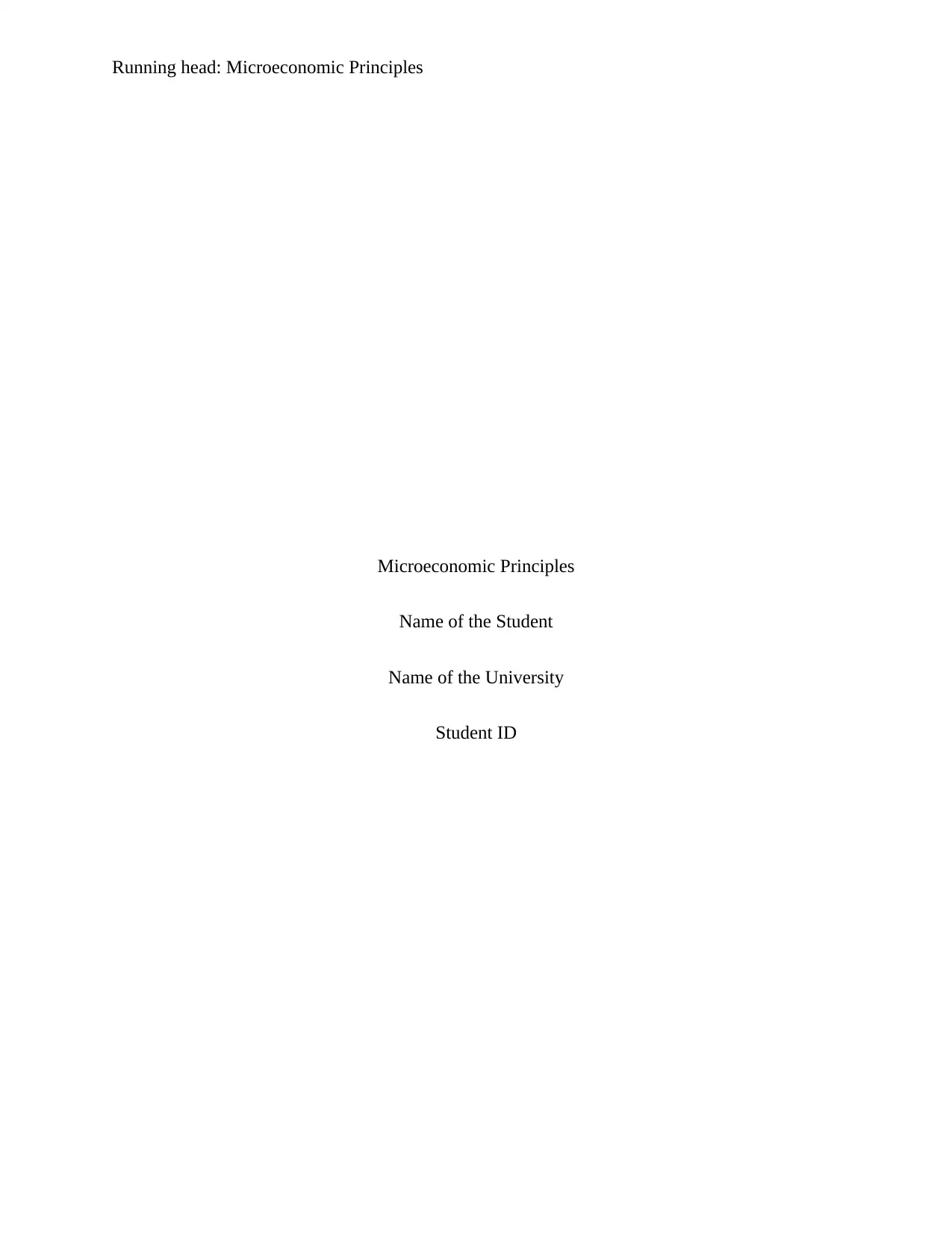
Running head: Microeconomic Principles
Microeconomic Principles
Name of the Student
Name of the University
Student ID
Microeconomic Principles
Name of the Student
Name of the University
Student ID
Secure Best Marks with AI Grader
Need help grading? Try our AI Grader for instant feedback on your assignments.
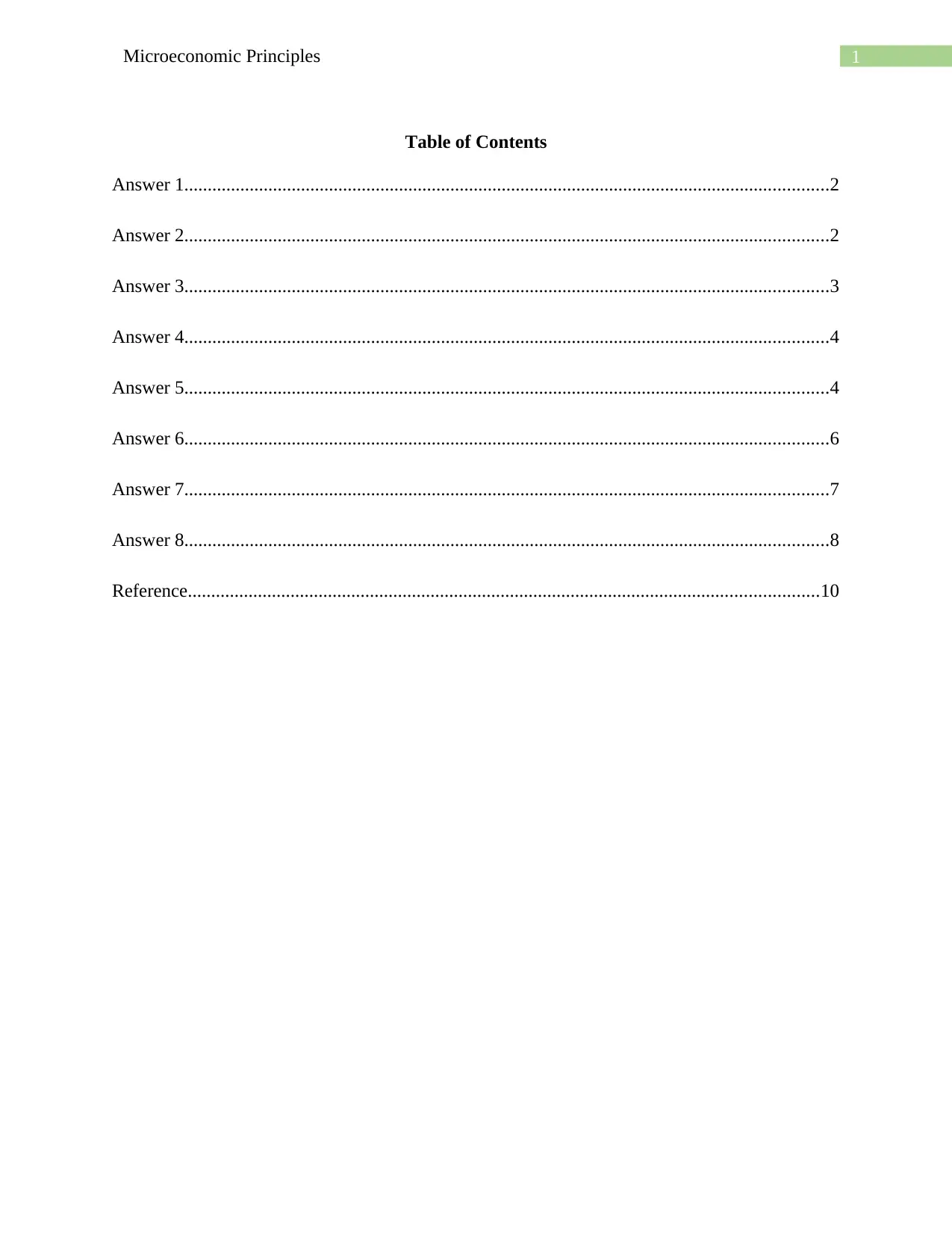
1Microeconomic Principles
Table of Contents
Answer 1..........................................................................................................................................2
Answer 2..........................................................................................................................................2
Answer 3..........................................................................................................................................3
Answer 4..........................................................................................................................................4
Answer 5..........................................................................................................................................4
Answer 6..........................................................................................................................................6
Answer 7..........................................................................................................................................7
Answer 8..........................................................................................................................................8
Reference.......................................................................................................................................10
Table of Contents
Answer 1..........................................................................................................................................2
Answer 2..........................................................................................................................................2
Answer 3..........................................................................................................................................3
Answer 4..........................................................................................................................................4
Answer 5..........................................................................................................................................4
Answer 6..........................................................................................................................................6
Answer 7..........................................................................................................................................7
Answer 8..........................................................................................................................................8
Reference.......................................................................................................................................10
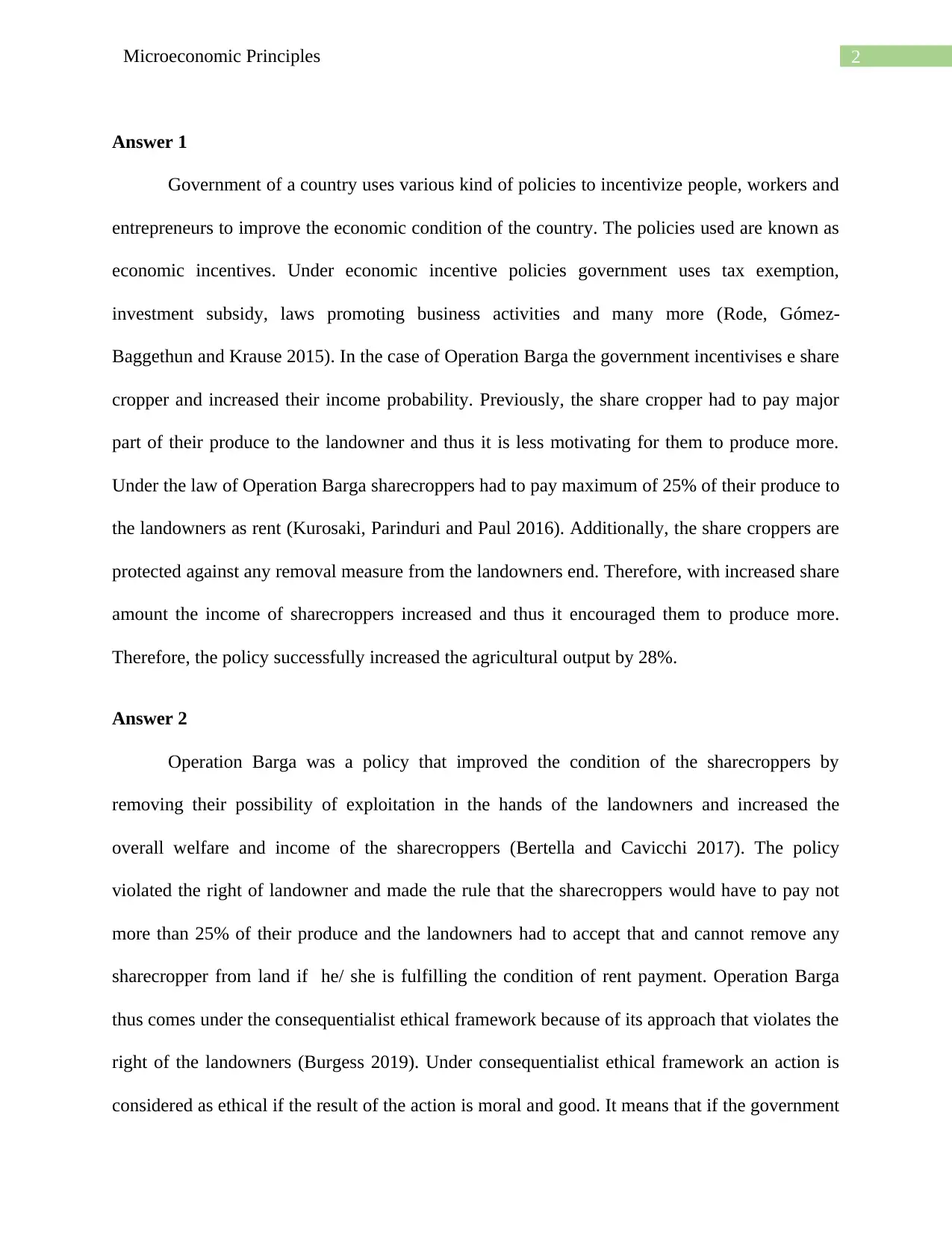
2Microeconomic Principles
Answer 1
Government of a country uses various kind of policies to incentivize people, workers and
entrepreneurs to improve the economic condition of the country. The policies used are known as
economic incentives. Under economic incentive policies government uses tax exemption,
investment subsidy, laws promoting business activities and many more (Rode, Gómez-
Baggethun and Krause 2015). In the case of Operation Barga the government incentivises e share
cropper and increased their income probability. Previously, the share cropper had to pay major
part of their produce to the landowner and thus it is less motivating for them to produce more.
Under the law of Operation Barga sharecroppers had to pay maximum of 25% of their produce to
the landowners as rent (Kurosaki, Parinduri and Paul 2016). Additionally, the share croppers are
protected against any removal measure from the landowners end. Therefore, with increased share
amount the income of sharecroppers increased and thus it encouraged them to produce more.
Therefore, the policy successfully increased the agricultural output by 28%.
Answer 2
Operation Barga was a policy that improved the condition of the sharecroppers by
removing their possibility of exploitation in the hands of the landowners and increased the
overall welfare and income of the sharecroppers (Bertella and Cavicchi 2017). The policy
violated the right of landowner and made the rule that the sharecroppers would have to pay not
more than 25% of their produce and the landowners had to accept that and cannot remove any
sharecropper from land if he/ she is fulfilling the condition of rent payment. Operation Barga
thus comes under the consequentialist ethical framework because of its approach that violates the
right of the landowners (Burgess 2019). Under consequentialist ethical framework an action is
considered as ethical if the result of the action is moral and good. It means that if the government
Answer 1
Government of a country uses various kind of policies to incentivize people, workers and
entrepreneurs to improve the economic condition of the country. The policies used are known as
economic incentives. Under economic incentive policies government uses tax exemption,
investment subsidy, laws promoting business activities and many more (Rode, Gómez-
Baggethun and Krause 2015). In the case of Operation Barga the government incentivises e share
cropper and increased their income probability. Previously, the share cropper had to pay major
part of their produce to the landowner and thus it is less motivating for them to produce more.
Under the law of Operation Barga sharecroppers had to pay maximum of 25% of their produce to
the landowners as rent (Kurosaki, Parinduri and Paul 2016). Additionally, the share croppers are
protected against any removal measure from the landowners end. Therefore, with increased share
amount the income of sharecroppers increased and thus it encouraged them to produce more.
Therefore, the policy successfully increased the agricultural output by 28%.
Answer 2
Operation Barga was a policy that improved the condition of the sharecroppers by
removing their possibility of exploitation in the hands of the landowners and increased the
overall welfare and income of the sharecroppers (Bertella and Cavicchi 2017). The policy
violated the right of landowner and made the rule that the sharecroppers would have to pay not
more than 25% of their produce and the landowners had to accept that and cannot remove any
sharecropper from land if he/ she is fulfilling the condition of rent payment. Operation Barga
thus comes under the consequentialist ethical framework because of its approach that violates the
right of the landowners (Burgess 2019). Under consequentialist ethical framework an action is
considered as ethical if the result of the action is moral and good. It means that if the government
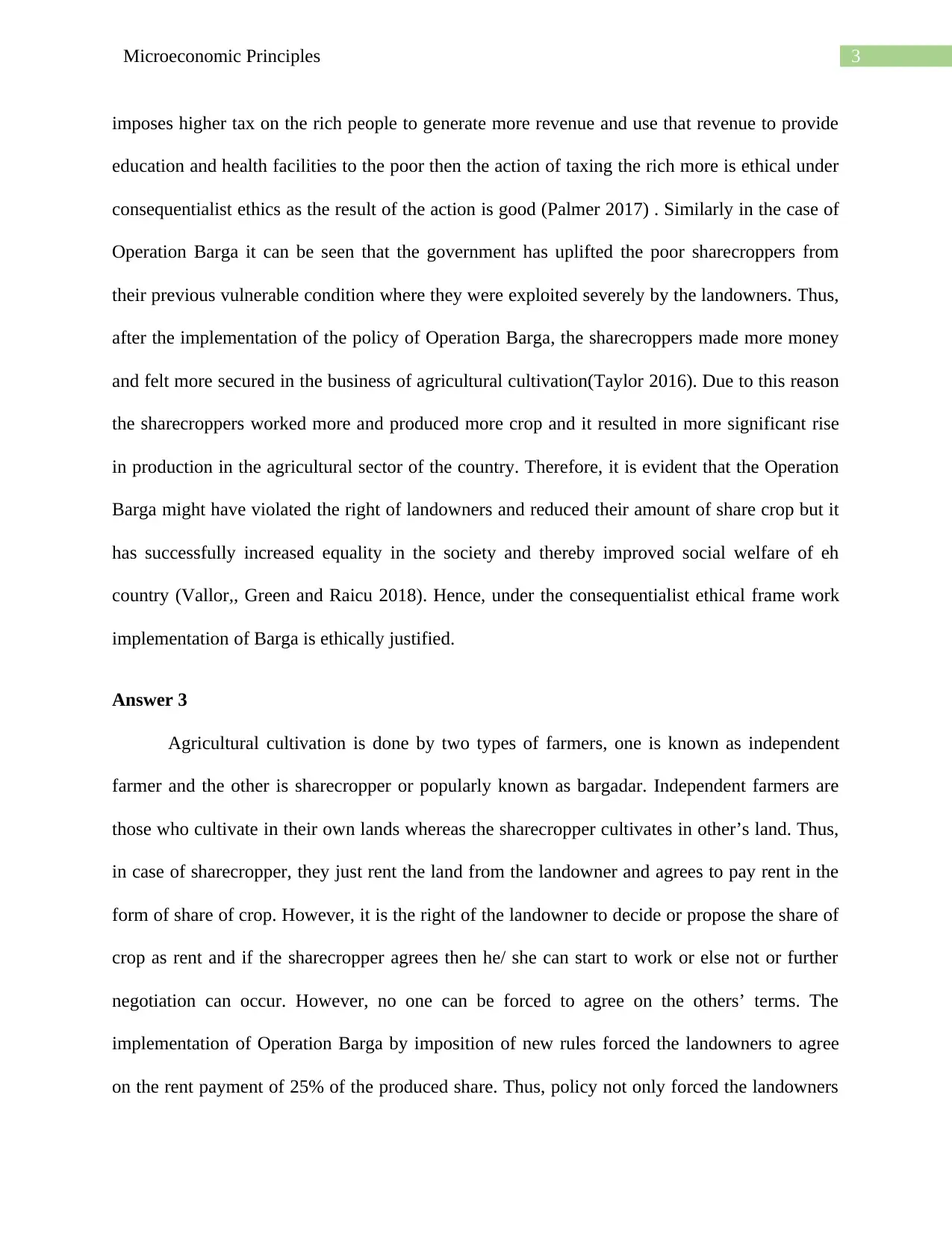
3Microeconomic Principles
imposes higher tax on the rich people to generate more revenue and use that revenue to provide
education and health facilities to the poor then the action of taxing the rich more is ethical under
consequentialist ethics as the result of the action is good (Palmer 2017) . Similarly in the case of
Operation Barga it can be seen that the government has uplifted the poor sharecroppers from
their previous vulnerable condition where they were exploited severely by the landowners. Thus,
after the implementation of the policy of Operation Barga, the sharecroppers made more money
and felt more secured in the business of agricultural cultivation(Taylor 2016). Due to this reason
the sharecroppers worked more and produced more crop and it resulted in more significant rise
in production in the agricultural sector of the country. Therefore, it is evident that the Operation
Barga might have violated the right of landowners and reduced their amount of share crop but it
has successfully increased equality in the society and thereby improved social welfare of eh
country (Vallor,, Green and Raicu 2018). Hence, under the consequentialist ethical frame work
implementation of Barga is ethically justified.
Answer 3
Agricultural cultivation is done by two types of farmers, one is known as independent
farmer and the other is sharecropper or popularly known as bargadar. Independent farmers are
those who cultivate in their own lands whereas the sharecropper cultivates in other’s land. Thus,
in case of sharecropper, they just rent the land from the landowner and agrees to pay rent in the
form of share of crop. However, it is the right of the landowner to decide or propose the share of
crop as rent and if the sharecropper agrees then he/ she can start to work or else not or further
negotiation can occur. However, no one can be forced to agree on the others’ terms. The
implementation of Operation Barga by imposition of new rules forced the landowners to agree
on the rent payment of 25% of the produced share. Thus, policy not only forced the landowners
imposes higher tax on the rich people to generate more revenue and use that revenue to provide
education and health facilities to the poor then the action of taxing the rich more is ethical under
consequentialist ethics as the result of the action is good (Palmer 2017) . Similarly in the case of
Operation Barga it can be seen that the government has uplifted the poor sharecroppers from
their previous vulnerable condition where they were exploited severely by the landowners. Thus,
after the implementation of the policy of Operation Barga, the sharecroppers made more money
and felt more secured in the business of agricultural cultivation(Taylor 2016). Due to this reason
the sharecroppers worked more and produced more crop and it resulted in more significant rise
in production in the agricultural sector of the country. Therefore, it is evident that the Operation
Barga might have violated the right of landowners and reduced their amount of share crop but it
has successfully increased equality in the society and thereby improved social welfare of eh
country (Vallor,, Green and Raicu 2018). Hence, under the consequentialist ethical frame work
implementation of Barga is ethically justified.
Answer 3
Agricultural cultivation is done by two types of farmers, one is known as independent
farmer and the other is sharecropper or popularly known as bargadar. Independent farmers are
those who cultivate in their own lands whereas the sharecropper cultivates in other’s land. Thus,
in case of sharecropper, they just rent the land from the landowner and agrees to pay rent in the
form of share of crop. However, it is the right of the landowner to decide or propose the share of
crop as rent and if the sharecropper agrees then he/ she can start to work or else not or further
negotiation can occur. However, no one can be forced to agree on the others’ terms. The
implementation of Operation Barga by imposition of new rules forced the landowners to agree
on the rent payment of 25% of the produced share. Thus, policy not only forced the landowners
Secure Best Marks with AI Grader
Need help grading? Try our AI Grader for instant feedback on your assignments.
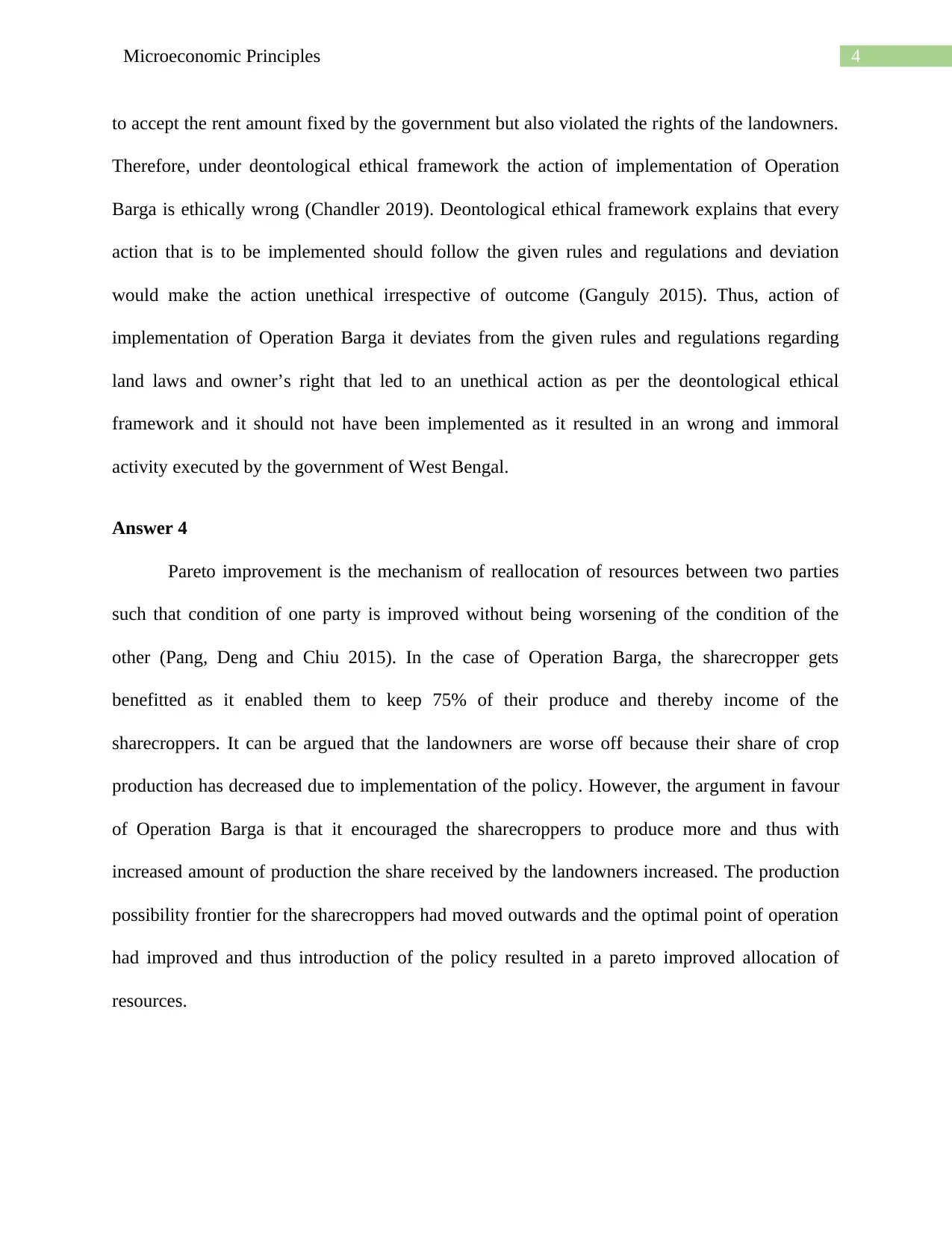
4Microeconomic Principles
to accept the rent amount fixed by the government but also violated the rights of the landowners.
Therefore, under deontological ethical framework the action of implementation of Operation
Barga is ethically wrong (Chandler 2019). Deontological ethical framework explains that every
action that is to be implemented should follow the given rules and regulations and deviation
would make the action unethical irrespective of outcome (Ganguly 2015). Thus, action of
implementation of Operation Barga it deviates from the given rules and regulations regarding
land laws and owner’s right that led to an unethical action as per the deontological ethical
framework and it should not have been implemented as it resulted in an wrong and immoral
activity executed by the government of West Bengal.
Answer 4
Pareto improvement is the mechanism of reallocation of resources between two parties
such that condition of one party is improved without being worsening of the condition of the
other (Pang, Deng and Chiu 2015). In the case of Operation Barga, the sharecropper gets
benefitted as it enabled them to keep 75% of their produce and thereby income of the
sharecroppers. It can be argued that the landowners are worse off because their share of crop
production has decreased due to implementation of the policy. However, the argument in favour
of Operation Barga is that it encouraged the sharecroppers to produce more and thus with
increased amount of production the share received by the landowners increased. The production
possibility frontier for the sharecroppers had moved outwards and the optimal point of operation
had improved and thus introduction of the policy resulted in a pareto improved allocation of
resources.
to accept the rent amount fixed by the government but also violated the rights of the landowners.
Therefore, under deontological ethical framework the action of implementation of Operation
Barga is ethically wrong (Chandler 2019). Deontological ethical framework explains that every
action that is to be implemented should follow the given rules and regulations and deviation
would make the action unethical irrespective of outcome (Ganguly 2015). Thus, action of
implementation of Operation Barga it deviates from the given rules and regulations regarding
land laws and owner’s right that led to an unethical action as per the deontological ethical
framework and it should not have been implemented as it resulted in an wrong and immoral
activity executed by the government of West Bengal.
Answer 4
Pareto improvement is the mechanism of reallocation of resources between two parties
such that condition of one party is improved without being worsening of the condition of the
other (Pang, Deng and Chiu 2015). In the case of Operation Barga, the sharecropper gets
benefitted as it enabled them to keep 75% of their produce and thereby income of the
sharecroppers. It can be argued that the landowners are worse off because their share of crop
production has decreased due to implementation of the policy. However, the argument in favour
of Operation Barga is that it encouraged the sharecroppers to produce more and thus with
increased amount of production the share received by the landowners increased. The production
possibility frontier for the sharecroppers had moved outwards and the optimal point of operation
had improved and thus introduction of the policy resulted in a pareto improved allocation of
resources.
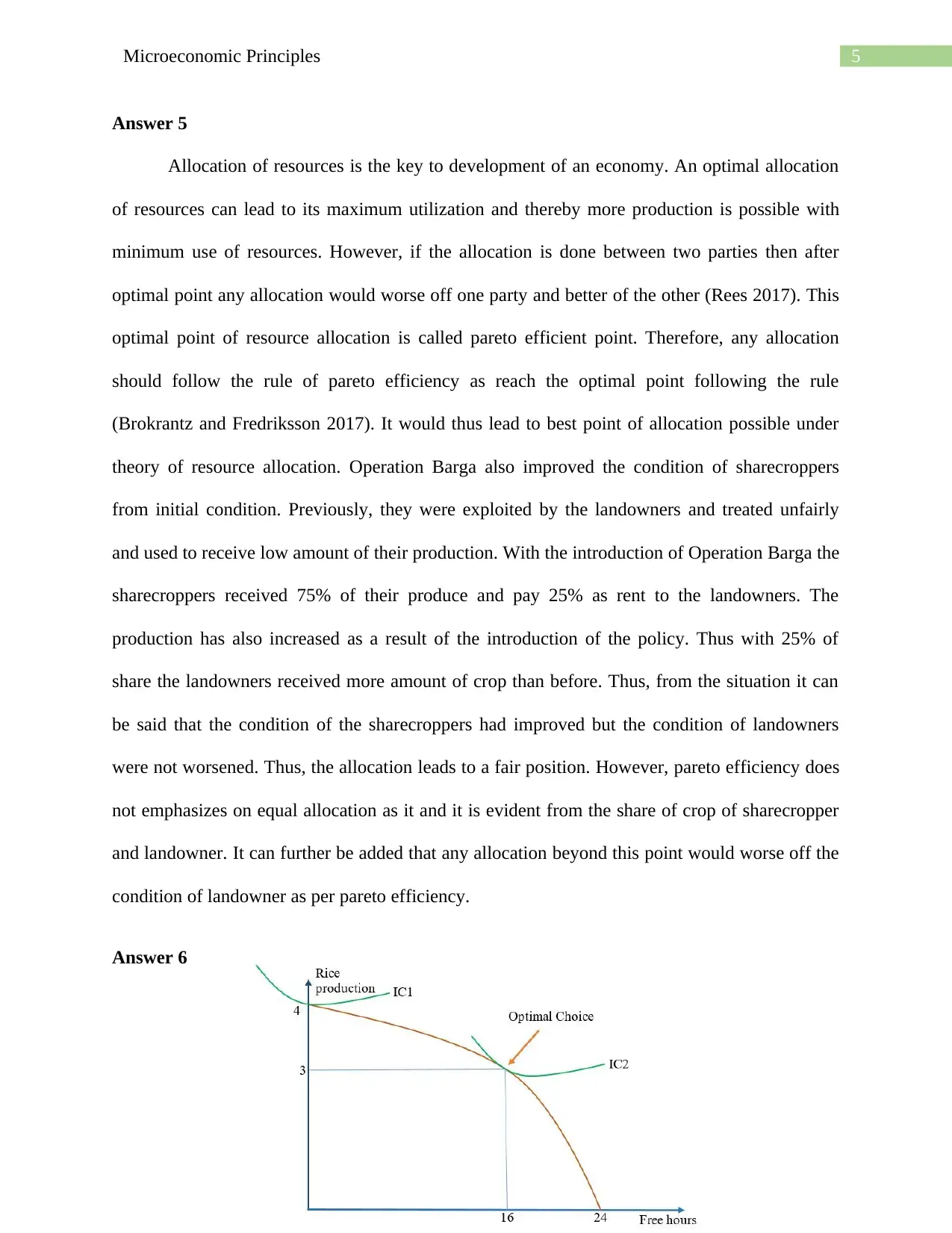
5Microeconomic Principles
Answer 5
Allocation of resources is the key to development of an economy. An optimal allocation
of resources can lead to its maximum utilization and thereby more production is possible with
minimum use of resources. However, if the allocation is done between two parties then after
optimal point any allocation would worse off one party and better of the other (Rees 2017). This
optimal point of resource allocation is called pareto efficient point. Therefore, any allocation
should follow the rule of pareto efficiency as reach the optimal point following the rule
(Brokrantz and Fredriksson 2017). It would thus lead to best point of allocation possible under
theory of resource allocation. Operation Barga also improved the condition of sharecroppers
from initial condition. Previously, they were exploited by the landowners and treated unfairly
and used to receive low amount of their production. With the introduction of Operation Barga the
sharecroppers received 75% of their produce and pay 25% as rent to the landowners. The
production has also increased as a result of the introduction of the policy. Thus with 25% of
share the landowners received more amount of crop than before. Thus, from the situation it can
be said that the condition of the sharecroppers had improved but the condition of landowners
were not worsened. Thus, the allocation leads to a fair position. However, pareto efficiency does
not emphasizes on equal allocation as it and it is evident from the share of crop of sharecropper
and landowner. It can further be added that any allocation beyond this point would worse off the
condition of landowner as per pareto efficiency.
Answer 6
Answer 5
Allocation of resources is the key to development of an economy. An optimal allocation
of resources can lead to its maximum utilization and thereby more production is possible with
minimum use of resources. However, if the allocation is done between two parties then after
optimal point any allocation would worse off one party and better of the other (Rees 2017). This
optimal point of resource allocation is called pareto efficient point. Therefore, any allocation
should follow the rule of pareto efficiency as reach the optimal point following the rule
(Brokrantz and Fredriksson 2017). It would thus lead to best point of allocation possible under
theory of resource allocation. Operation Barga also improved the condition of sharecroppers
from initial condition. Previously, they were exploited by the landowners and treated unfairly
and used to receive low amount of their production. With the introduction of Operation Barga the
sharecroppers received 75% of their produce and pay 25% as rent to the landowners. The
production has also increased as a result of the introduction of the policy. Thus with 25% of
share the landowners received more amount of crop than before. Thus, from the situation it can
be said that the condition of the sharecroppers had improved but the condition of landowners
were not worsened. Thus, the allocation leads to a fair position. However, pareto efficiency does
not emphasizes on equal allocation as it and it is evident from the share of crop of sharecropper
and landowner. It can further be added that any allocation beyond this point would worse off the
condition of landowner as per pareto efficiency.
Answer 6
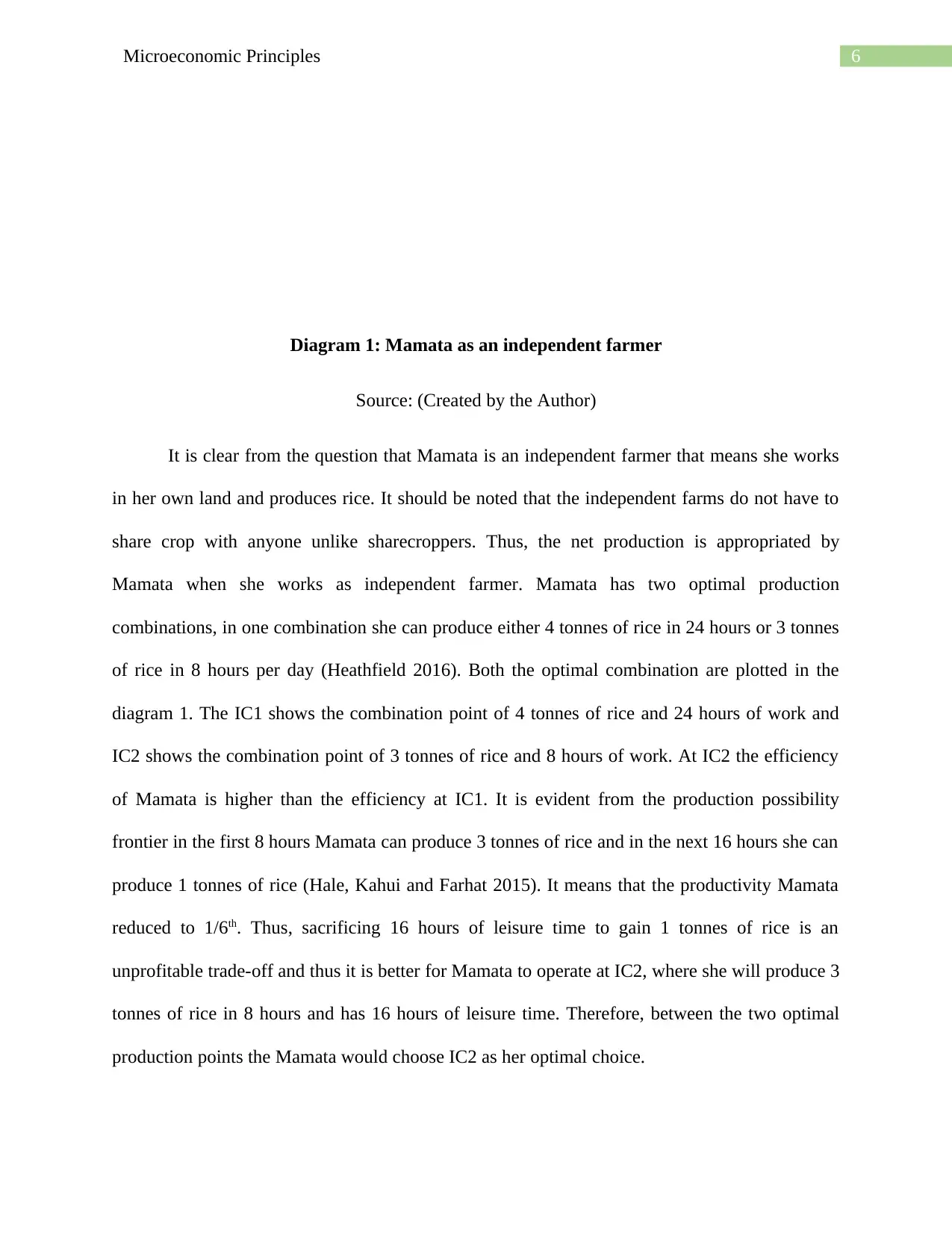
6Microeconomic Principles
Diagram 1: Mamata as an independent farmer
Source: (Created by the Author)
It is clear from the question that Mamata is an independent farmer that means she works
in her own land and produces rice. It should be noted that the independent farms do not have to
share crop with anyone unlike sharecroppers. Thus, the net production is appropriated by
Mamata when she works as independent farmer. Mamata has two optimal production
combinations, in one combination she can produce either 4 tonnes of rice in 24 hours or 3 tonnes
of rice in 8 hours per day (Heathfield 2016). Both the optimal combination are plotted in the
diagram 1. The IC1 shows the combination point of 4 tonnes of rice and 24 hours of work and
IC2 shows the combination point of 3 tonnes of rice and 8 hours of work. At IC2 the efficiency
of Mamata is higher than the efficiency at IC1. It is evident from the production possibility
frontier in the first 8 hours Mamata can produce 3 tonnes of rice and in the next 16 hours she can
produce 1 tonnes of rice (Hale, Kahui and Farhat 2015). It means that the productivity Mamata
reduced to 1/6th. Thus, sacrificing 16 hours of leisure time to gain 1 tonnes of rice is an
unprofitable trade-off and thus it is better for Mamata to operate at IC2, where she will produce 3
tonnes of rice in 8 hours and has 16 hours of leisure time. Therefore, between the two optimal
production points the Mamata would choose IC2 as her optimal choice.
Diagram 1: Mamata as an independent farmer
Source: (Created by the Author)
It is clear from the question that Mamata is an independent farmer that means she works
in her own land and produces rice. It should be noted that the independent farms do not have to
share crop with anyone unlike sharecroppers. Thus, the net production is appropriated by
Mamata when she works as independent farmer. Mamata has two optimal production
combinations, in one combination she can produce either 4 tonnes of rice in 24 hours or 3 tonnes
of rice in 8 hours per day (Heathfield 2016). Both the optimal combination are plotted in the
diagram 1. The IC1 shows the combination point of 4 tonnes of rice and 24 hours of work and
IC2 shows the combination point of 3 tonnes of rice and 8 hours of work. At IC2 the efficiency
of Mamata is higher than the efficiency at IC1. It is evident from the production possibility
frontier in the first 8 hours Mamata can produce 3 tonnes of rice and in the next 16 hours she can
produce 1 tonnes of rice (Hale, Kahui and Farhat 2015). It means that the productivity Mamata
reduced to 1/6th. Thus, sacrificing 16 hours of leisure time to gain 1 tonnes of rice is an
unprofitable trade-off and thus it is better for Mamata to operate at IC2, where she will produce 3
tonnes of rice in 8 hours and has 16 hours of leisure time. Therefore, between the two optimal
production points the Mamata would choose IC2 as her optimal choice.
Paraphrase This Document
Need a fresh take? Get an instant paraphrase of this document with our AI Paraphraser
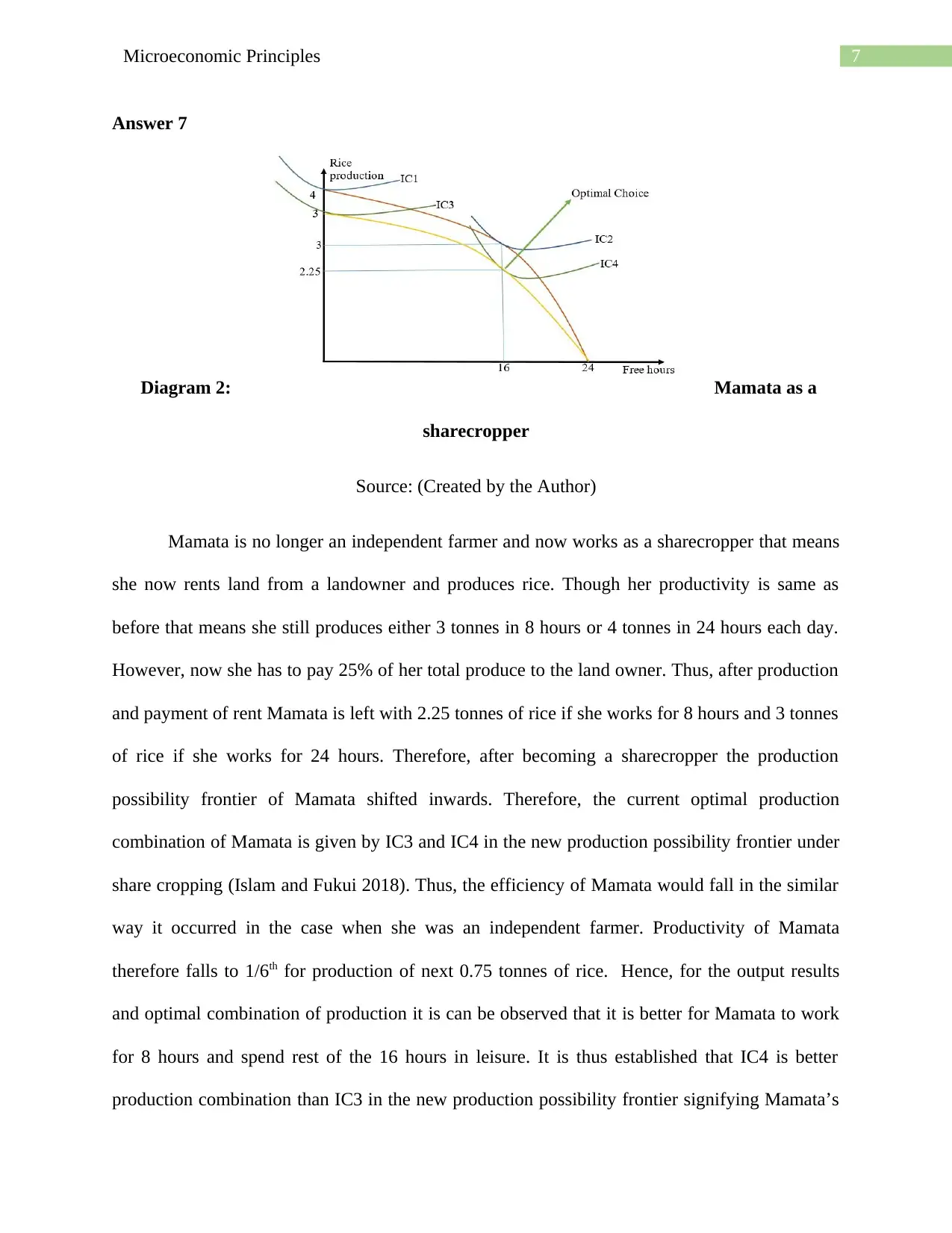
7Microeconomic Principles
Answer 7
Diagram 2: Mamata as a
sharecropper
Source: (Created by the Author)
Mamata is no longer an independent farmer and now works as a sharecropper that means
she now rents land from a landowner and produces rice. Though her productivity is same as
before that means she still produces either 3 tonnes in 8 hours or 4 tonnes in 24 hours each day.
However, now she has to pay 25% of her total produce to the land owner. Thus, after production
and payment of rent Mamata is left with 2.25 tonnes of rice if she works for 8 hours and 3 tonnes
of rice if she works for 24 hours. Therefore, after becoming a sharecropper the production
possibility frontier of Mamata shifted inwards. Therefore, the current optimal production
combination of Mamata is given by IC3 and IC4 in the new production possibility frontier under
share cropping (Islam and Fukui 2018). Thus, the efficiency of Mamata would fall in the similar
way it occurred in the case when she was an independent farmer. Productivity of Mamata
therefore falls to 1/6th for production of next 0.75 tonnes of rice. Hence, for the output results
and optimal combination of production it is can be observed that it is better for Mamata to work
for 8 hours and spend rest of the 16 hours in leisure. It is thus established that IC4 is better
production combination than IC3 in the new production possibility frontier signifying Mamata’s
Answer 7
Diagram 2: Mamata as a
sharecropper
Source: (Created by the Author)
Mamata is no longer an independent farmer and now works as a sharecropper that means
she now rents land from a landowner and produces rice. Though her productivity is same as
before that means she still produces either 3 tonnes in 8 hours or 4 tonnes in 24 hours each day.
However, now she has to pay 25% of her total produce to the land owner. Thus, after production
and payment of rent Mamata is left with 2.25 tonnes of rice if she works for 8 hours and 3 tonnes
of rice if she works for 24 hours. Therefore, after becoming a sharecropper the production
possibility frontier of Mamata shifted inwards. Therefore, the current optimal production
combination of Mamata is given by IC3 and IC4 in the new production possibility frontier under
share cropping (Islam and Fukui 2018). Thus, the efficiency of Mamata would fall in the similar
way it occurred in the case when she was an independent farmer. Productivity of Mamata
therefore falls to 1/6th for production of next 0.75 tonnes of rice. Hence, for the output results
and optimal combination of production it is can be observed that it is better for Mamata to work
for 8 hours and spend rest of the 16 hours in leisure. It is thus established that IC4 is better
production combination than IC3 in the new production possibility frontier signifying Mamata’s
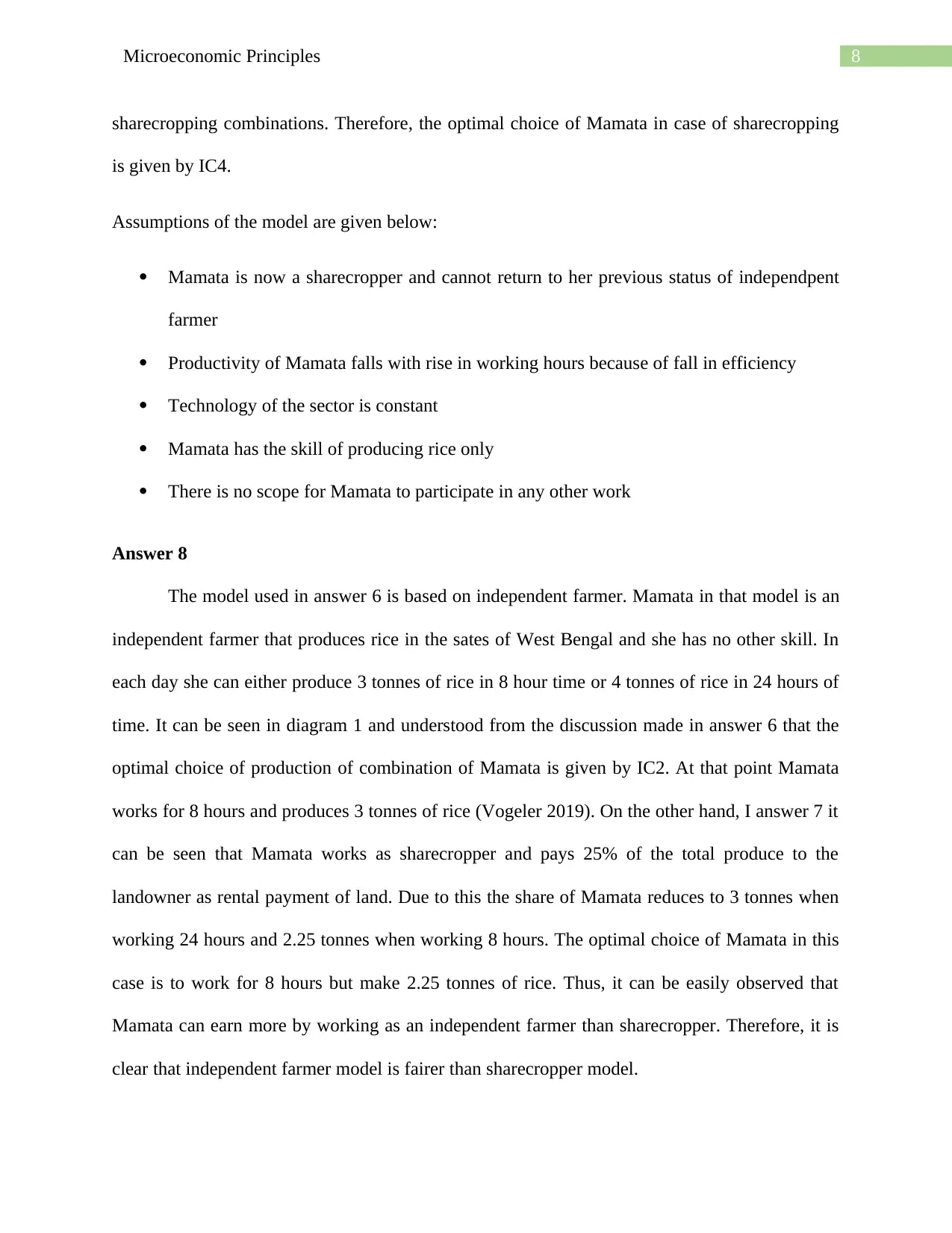
8Microeconomic Principles
sharecropping combinations. Therefore, the optimal choice of Mamata in case of sharecropping
is given by IC4.
Assumptions of the model are given below:
Mamata is now a sharecropper and cannot return to her previous status of independpent
farmer
Productivity of Mamata falls with rise in working hours because of fall in efficiency
Technology of the sector is constant
Mamata has the skill of producing rice only
There is no scope for Mamata to participate in any other work
Answer 8
The model used in answer 6 is based on independent farmer. Mamata in that model is an
independent farmer that produces rice in the sates of West Bengal and she has no other skill. In
each day she can either produce 3 tonnes of rice in 8 hour time or 4 tonnes of rice in 24 hours of
time. It can be seen in diagram 1 and understood from the discussion made in answer 6 that the
optimal choice of production of combination of Mamata is given by IC2. At that point Mamata
works for 8 hours and produces 3 tonnes of rice (Vogeler 2019). On the other hand, I answer 7 it
can be seen that Mamata works as sharecropper and pays 25% of the total produce to the
landowner as rental payment of land. Due to this the share of Mamata reduces to 3 tonnes when
working 24 hours and 2.25 tonnes when working 8 hours. The optimal choice of Mamata in this
case is to work for 8 hours but make 2.25 tonnes of rice. Thus, it can be easily observed that
Mamata can earn more by working as an independent farmer than sharecropper. Therefore, it is
clear that independent farmer model is fairer than sharecropper model.
sharecropping combinations. Therefore, the optimal choice of Mamata in case of sharecropping
is given by IC4.
Assumptions of the model are given below:
Mamata is now a sharecropper and cannot return to her previous status of independpent
farmer
Productivity of Mamata falls with rise in working hours because of fall in efficiency
Technology of the sector is constant
Mamata has the skill of producing rice only
There is no scope for Mamata to participate in any other work
Answer 8
The model used in answer 6 is based on independent farmer. Mamata in that model is an
independent farmer that produces rice in the sates of West Bengal and she has no other skill. In
each day she can either produce 3 tonnes of rice in 8 hour time or 4 tonnes of rice in 24 hours of
time. It can be seen in diagram 1 and understood from the discussion made in answer 6 that the
optimal choice of production of combination of Mamata is given by IC2. At that point Mamata
works for 8 hours and produces 3 tonnes of rice (Vogeler 2019). On the other hand, I answer 7 it
can be seen that Mamata works as sharecropper and pays 25% of the total produce to the
landowner as rental payment of land. Due to this the share of Mamata reduces to 3 tonnes when
working 24 hours and 2.25 tonnes when working 8 hours. The optimal choice of Mamata in this
case is to work for 8 hours but make 2.25 tonnes of rice. Thus, it can be easily observed that
Mamata can earn more by working as an independent farmer than sharecropper. Therefore, it is
clear that independent farmer model is fairer than sharecropper model.

9Microeconomic Principles
Secure Best Marks with AI Grader
Need help grading? Try our AI Grader for instant feedback on your assignments.
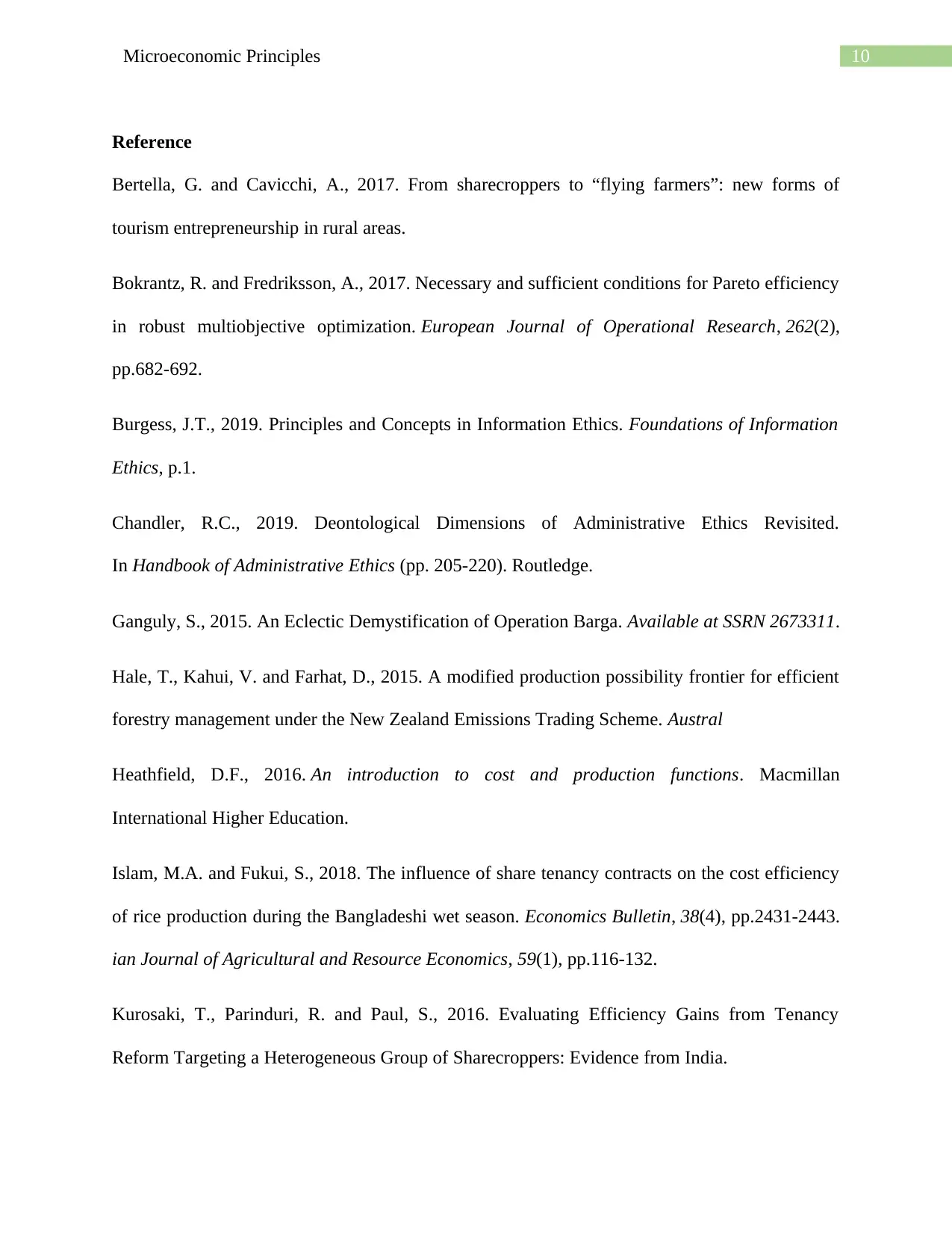
10Microeconomic Principles
Reference
Bertella, G. and Cavicchi, A., 2017. From sharecroppers to “flying farmers”: new forms of
tourism entrepreneurship in rural areas.
Bokrantz, R. and Fredriksson, A., 2017. Necessary and sufficient conditions for Pareto efficiency
in robust multiobjective optimization. European Journal of Operational Research, 262(2),
pp.682-692.
Burgess, J.T., 2019. Principles and Concepts in Information Ethics. Foundations of Information
Ethics, p.1.
Chandler, R.C., 2019. Deontological Dimensions of Administrative Ethics Revisited.
In Handbook of Administrative Ethics (pp. 205-220). Routledge.
Ganguly, S., 2015. An Eclectic Demystification of Operation Barga. Available at SSRN 2673311.
Hale, T., Kahui, V. and Farhat, D., 2015. A modified production possibility frontier for efficient
forestry management under the New Zealand Emissions Trading Scheme. Austral
Heathfield, D.F., 2016. An introduction to cost and production functions. Macmillan
International Higher Education.
Islam, M.A. and Fukui, S., 2018. The influence of share tenancy contracts on the cost efficiency
of rice production during the Bangladeshi wet season. Economics Bulletin, 38(4), pp.2431-2443.
ian Journal of Agricultural and Resource Economics, 59(1), pp.116-132.
Kurosaki, T., Parinduri, R. and Paul, S., 2016. Evaluating Efficiency Gains from Tenancy
Reform Targeting a Heterogeneous Group of Sharecroppers: Evidence from India.
Reference
Bertella, G. and Cavicchi, A., 2017. From sharecroppers to “flying farmers”: new forms of
tourism entrepreneurship in rural areas.
Bokrantz, R. and Fredriksson, A., 2017. Necessary and sufficient conditions for Pareto efficiency
in robust multiobjective optimization. European Journal of Operational Research, 262(2),
pp.682-692.
Burgess, J.T., 2019. Principles and Concepts in Information Ethics. Foundations of Information
Ethics, p.1.
Chandler, R.C., 2019. Deontological Dimensions of Administrative Ethics Revisited.
In Handbook of Administrative Ethics (pp. 205-220). Routledge.
Ganguly, S., 2015. An Eclectic Demystification of Operation Barga. Available at SSRN 2673311.
Hale, T., Kahui, V. and Farhat, D., 2015. A modified production possibility frontier for efficient
forestry management under the New Zealand Emissions Trading Scheme. Austral
Heathfield, D.F., 2016. An introduction to cost and production functions. Macmillan
International Higher Education.
Islam, M.A. and Fukui, S., 2018. The influence of share tenancy contracts on the cost efficiency
of rice production during the Bangladeshi wet season. Economics Bulletin, 38(4), pp.2431-2443.
ian Journal of Agricultural and Resource Economics, 59(1), pp.116-132.
Kurosaki, T., Parinduri, R. and Paul, S., 2016. Evaluating Efficiency Gains from Tenancy
Reform Targeting a Heterogeneous Group of Sharecroppers: Evidence from India.
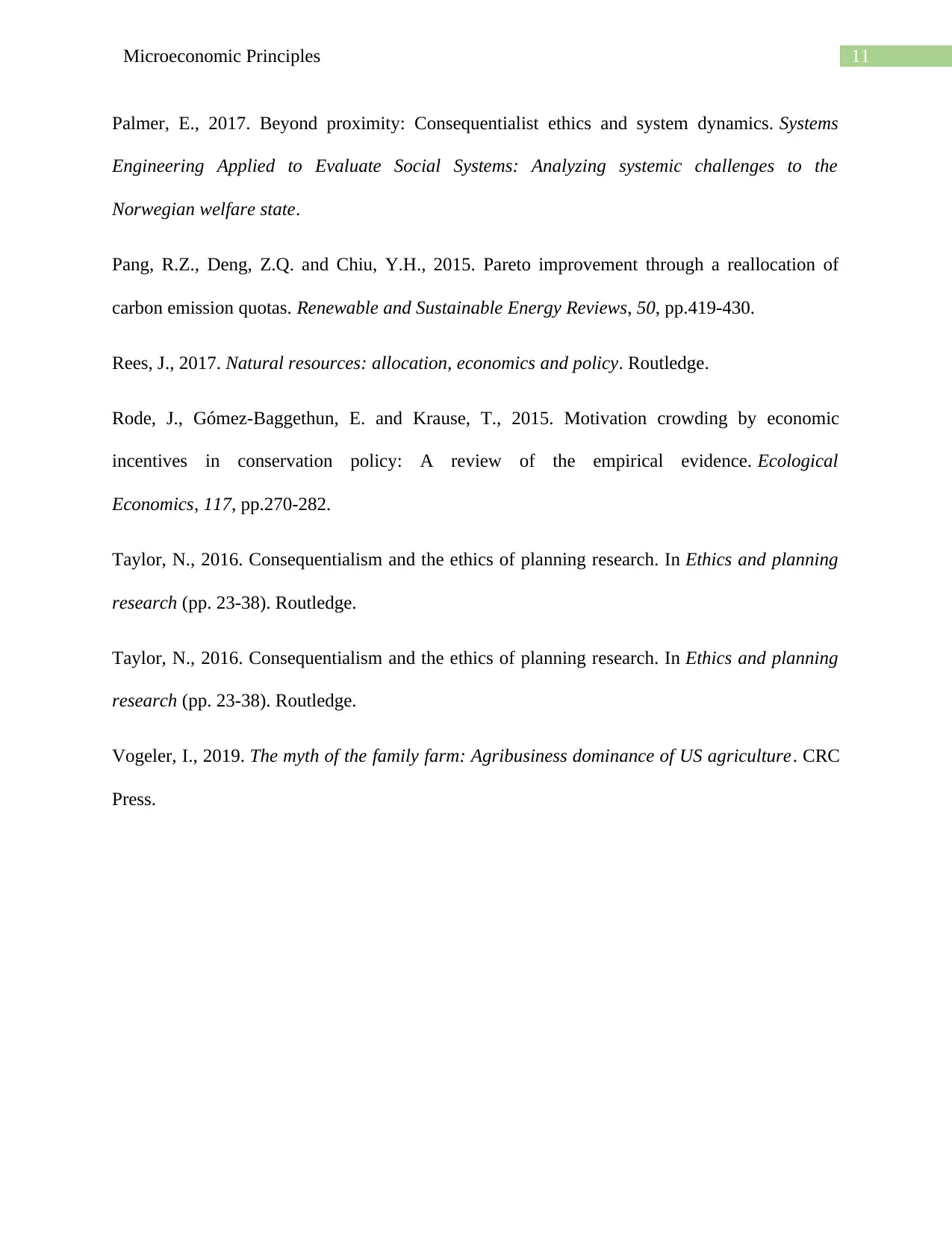
11Microeconomic Principles
Palmer, E., 2017. Beyond proximity: Consequentialist ethics and system dynamics. Systems
Engineering Applied to Evaluate Social Systems: Analyzing systemic challenges to the
Norwegian welfare state.
Pang, R.Z., Deng, Z.Q. and Chiu, Y.H., 2015. Pareto improvement through a reallocation of
carbon emission quotas. Renewable and Sustainable Energy Reviews, 50, pp.419-430.
Rees, J., 2017. Natural resources: allocation, economics and policy. Routledge.
Rode, J., Gómez-Baggethun, E. and Krause, T., 2015. Motivation crowding by economic
incentives in conservation policy: A review of the empirical evidence. Ecological
Economics, 117, pp.270-282.
Taylor, N., 2016. Consequentialism and the ethics of planning research. In Ethics and planning
research (pp. 23-38). Routledge.
Taylor, N., 2016. Consequentialism and the ethics of planning research. In Ethics and planning
research (pp. 23-38). Routledge.
Vogeler, I., 2019. The myth of the family farm: Agribusiness dominance of US agriculture. CRC
Press.
Palmer, E., 2017. Beyond proximity: Consequentialist ethics and system dynamics. Systems
Engineering Applied to Evaluate Social Systems: Analyzing systemic challenges to the
Norwegian welfare state.
Pang, R.Z., Deng, Z.Q. and Chiu, Y.H., 2015. Pareto improvement through a reallocation of
carbon emission quotas. Renewable and Sustainable Energy Reviews, 50, pp.419-430.
Rees, J., 2017. Natural resources: allocation, economics and policy. Routledge.
Rode, J., Gómez-Baggethun, E. and Krause, T., 2015. Motivation crowding by economic
incentives in conservation policy: A review of the empirical evidence. Ecological
Economics, 117, pp.270-282.
Taylor, N., 2016. Consequentialism and the ethics of planning research. In Ethics and planning
research (pp. 23-38). Routledge.
Taylor, N., 2016. Consequentialism and the ethics of planning research. In Ethics and planning
research (pp. 23-38). Routledge.
Vogeler, I., 2019. The myth of the family farm: Agribusiness dominance of US agriculture. CRC
Press.
1 out of 12
Related Documents
Your All-in-One AI-Powered Toolkit for Academic Success.
+13062052269
info@desklib.com
Available 24*7 on WhatsApp / Email
![[object Object]](/_next/static/media/star-bottom.7253800d.svg)
Unlock your academic potential
© 2024 | Zucol Services PVT LTD | All rights reserved.





